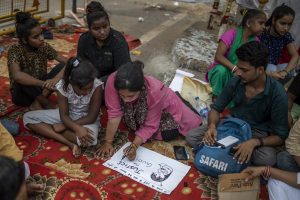Last week, a nine-year-old girl from the Dalit (formerly “untouchable”) community was allegedly gang-raped, murdered and forcibly burnt in New Delhi. The girl, a daughter of rag-pickers, had reportedly gone to a crematorium to fetch drinking water. She never returned.
Hours later, a priest at the crematorium, Radhe Shyam, called for her mother.
“At the crematorium, I found her lying on the ground. Her lips were blue, there was blood under her nose, she had bruises on her hands and arms and her clothes were wet,” her mother recalls.
“Your daughter will be cremated. What had to happen has happened. No need to scream now. We’ll settle this here,” Radhey Shyam, one of the accused, told the victim’s mother. He said that the girl had died of electrocution, but the mother didn’t believe it after seeing the bruises on her daughter’s body, according to her statements.
The suspected assailants – the priest and three other men – have since been arrested.
The family and two other witnesses told the New York Times that some police officers stood by and did nothing to stop the young victim’s forced cremation. The victim’s mother added that she and the father were taken to the police station where they were beaten and intimidated.
Ingit Pratap Singh, the deputy commissioner of police for Southwest Delhi, has denied both the accusations of the police standing by at the crematorium and the family being mistreated at the station.
According to National Crime Records Bureau (NCRB) data, India reported a total 32,033 rape cases in 2019; 11 percent were from the Dalit community.
Every fourth rape victim in India is a child, according to NCRB statistics.
Although the practice of “untouchability” is prohibited under the Indian Constitution, caste-based discrimination and violence continues to be practiced. The Scheduled Castes/Scheduled Tribes Act, 1989, made offences against Scheduled Castes (as Dalits are officially known) and Scheduled Tribes (as indigenous groups are officially known) non-bailable offences and provided for special trial courts. But the law remains weak in implementation. According to the 2019 NCRB report, 94 percent of cases registered under the act are pending, and the conviction rate for such cases is just 32 percent nationally.
Sexual violence against Dalit women is on the rise in India. While the total number of reported rapes dropped by 5 percent between 2009 and 2019, for Dalit women they rose by nearly 160 percent from 1,346 cases to 3,486 cases.
What happened in Delhi is not an isolated incident. In 2019, almost 10 Dalit women or girls were raped every day in India. The real numbers may be much higher as reporting of sexual violence remains low – an estimated 99 percent of sexual assault cases in India go unreported.
“Violence, including rape and gang rape, have been systematically utilised as weapons by dominant castes to oppress Dalit women and girls and reinforce structural gender and caste hierarchies,” states a recent report by Equality Now, a global women’s rights’ non-profit and Swabhiman Society, a Dalit-led grassroots organization in India. The report finds that in the state of Haryana, a vast majority of sexual violence cases against Dalit women and girls — over 80 percent — were committed by men from dominant castes.
“Dalit women’s bodies are being used to assert caste supremacy and keep women ‘in their place’” said Jacqui Hunt, the Eurasia Director of Equality Now, in a statement.
“Perpetrators from dominant castes know they are likely to go unpunished because every branch and echelon of the system is weighted in their favour, and this impunity for rape creates an enabling environment that fosters further abuse.”
Access to justice is tougher given the culture of impunity regarding both caste-based violence and sexual violence and the intersecting forms of gender, caste, and class discrimination that Dalit women face in India. The rate of conviction in cases of rape against Dalits is only 32 percent in 2019, according to the NCRB.
In September 2020, a 19-year-old was gang-raped and brutalized by four upper caste men in Hathras, Uttar Pradesh. The woman’s body was then forcibly cremated by the Uttar Pradesh police without the consent and knowledge of her family.
The Equality Now and Swabhiman Society report finds that in over half the cases (57.5 percent) community and social pressure was employed to impede access to justice by pushing the survivor or her family into extra-judicial settlements or compromises. In the 40 caste-based sexual violence cases studied by the report, khap panchayats — caste or community councils in villages that are illegal — attempted to interfere with the justice process in over 80 percent of the cases. These councils would often employ their economic, social, and political power to threaten, intimidate and coerce the survivor or their family members into silence or refrain from pursuing the criminal case.
Only 10 percent of the cases studied in the report ended in conviction of all those who were charged.
The Delhi and Hathras case are a reminder of the horrific violence that Dalit women face. India’s caste system continues to place Dalit women at the bottom of its gender and caste hierarchy. Their access to justice remains limited and it normalizes violence against Dalit women.

































